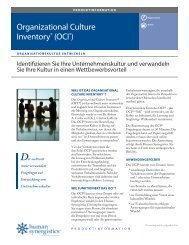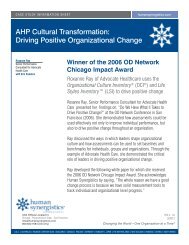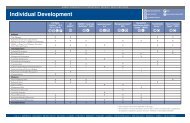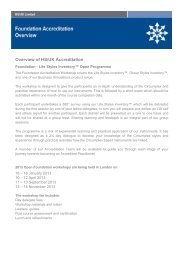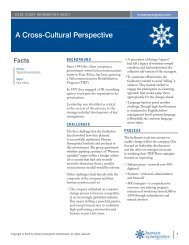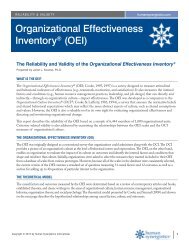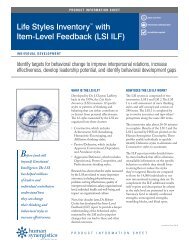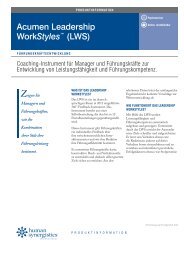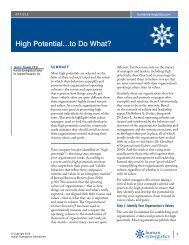Developing a Sales Culture in Retail Banking - Human Synergistics
Developing a Sales Culture in Retail Banking - Human Synergistics
Developing a Sales Culture in Retail Banking - Human Synergistics
Create successful ePaper yourself
Turn your PDF publications into a flip-book with our unique Google optimized e-Paper software.
CASE STUDY INFORMATION SHEET<br />
humansynergistics.com<br />
<strong>Develop<strong>in</strong>g</strong> a <strong>Sales</strong> <strong>Culture</strong><br />
<strong>in</strong> <strong>Retail</strong> Bank<strong>in</strong>g<br />
Facts<br />
Industry<br />
<strong>Retail</strong> Bank<strong>in</strong>g<br />
Size<br />
4,000 employees<br />
Total Assets<br />
Approximately US $14 billion<br />
Income<br />
Approximately US $1.3 billion<br />
Net Profit<br />
Approximately US $112 million<br />
Note: International currencies have been<br />
converted to US dollars.<br />
Orientation Build<strong>in</strong>g<br />
Achievement:<br />
• Goal sett<strong>in</strong>g, problem solv<strong>in</strong>g, and<br />
analytical skills<br />
• Strategic and performance<br />
management practices<br />
• Track<strong>in</strong>g and measur<strong>in</strong>g goal<br />
achievement<br />
• Manag<strong>in</strong>g sales and market<strong>in</strong>g activities<br />
• Build<strong>in</strong>g Achievement-oriented<br />
cultures at the branch level<br />
<strong>Human</strong>istic-Encourag<strong>in</strong>g,<br />
Self-Actualiz<strong>in</strong>g:<br />
• Coach<strong>in</strong>g for superior performance<br />
• Build<strong>in</strong>g effective work teams<br />
• Manag<strong>in</strong>g <strong>in</strong>fluence (i.e.,<br />
empowerment)<br />
• <strong>Develop<strong>in</strong>g</strong> a success-oriented culture<br />
• Emphasiz<strong>in</strong>g learn<strong>in</strong>g and growth<br />
• Creative job design and motivational<br />
processes<br />
• Effective communication<br />
Challenge<br />
Few <strong>in</strong>dustries have experienced the rapidity of change<br />
imposed upon the retail bank<strong>in</strong>g <strong>in</strong>dustry <strong>in</strong> the ‘90s.<br />
With economic conditions exert<strong>in</strong>g severe pressure on<br />
<strong>in</strong>terest marg<strong>in</strong>s, banks have had to explore alternative<br />
ways of operat<strong>in</strong>g—at a time of <strong>in</strong>creas<strong>in</strong>g costs, and <strong>in</strong><br />
a market where the consumer has become much more<br />
aware of the products, costs, and values be<strong>in</strong>g provided.<br />
The bank<strong>in</strong>g <strong>in</strong>dustry has responded to<br />
this need by employ<strong>in</strong>g two strategies:<br />
1. Critical mass, whereby mergers and<br />
acquisitions provide efficiencies<br />
through <strong>in</strong>creased size.<br />
2. <strong>Sales</strong> and customer service, whereby<br />
banks emphasize sales and profit<br />
growth through <strong>in</strong>creased bus<strong>in</strong>ess<br />
(and profitability) per customer.<br />
The net result of these strategies is a<br />
highly competitive <strong>in</strong>dustry where<strong>in</strong><br />
banks seek to reta<strong>in</strong> their exist<strong>in</strong>g<br />
customer base, obta<strong>in</strong> more bus<strong>in</strong>ess<br />
from exist<strong>in</strong>g customers, and attract<br />
customers away from their competitors.<br />
And this <strong>in</strong> an economy that is,<br />
technically speak<strong>in</strong>g, “over-banked.”<br />
The bank profiled <strong>in</strong> this case study<br />
<strong>in</strong>itially focused on build<strong>in</strong>g growth<br />
through the second of the two strategies:<br />
sales and customer service. While growth<br />
through acquisition was fundamental, even<br />
more important was gett<strong>in</strong>g the basics of<br />
bank<strong>in</strong>g right with<strong>in</strong> their own bus<strong>in</strong>ess<br />
<strong>in</strong> order to capitalize on new marketplace<br />
opportunities.<br />
GOALS<br />
Specifically, the bank sought to atta<strong>in</strong><br />
growth <strong>in</strong> three areas: both <strong>in</strong>terest<br />
and non-<strong>in</strong>terest related products;<br />
profitability per customer (particularly<br />
<strong>in</strong> “high net worth” customers); and<br />
branch profitability.<br />
To accomplish these goals, the bank’s<br />
leadership determ<strong>in</strong>ed the need for the<br />
development of a “sales culture.“<br />
BUSINESS ISSUES AND<br />
STRATEGIES<br />
To stay competitive, the bank’s<br />
leadership knew that they must ensure<br />
a balanced mix of delivery platforms,<br />
with <strong>in</strong>-branch sales and service,<br />
electronic bank<strong>in</strong>g, mobile sales/<br />
response units, and event-related “shop<br />
fronts.” However, s<strong>in</strong>ce all banks were<br />
pursu<strong>in</strong>g similar strategies, the only<br />
real competitive advantage was the<br />
bank’s people.<br />
To build a sales culture, the bank’s<br />
leadership recognized the need for<br />
Copyright © 2012 by <strong>Human</strong> <strong>Synergistics</strong> International. All rights reserved.<br />
1
CASE STUDY INFORMATION SHEET<br />
humansynergistics.com<br />
<strong>Develop<strong>in</strong>g</strong> a <strong>Sales</strong> <strong>Culture</strong> <strong>in</strong> <strong>Retail</strong> Bank<strong>in</strong>g<br />
Figure 1: Year 1 OCI Profile*—<br />
<strong>Culture</strong><br />
Copyright © by <strong>Human</strong> <strong>Synergistics</strong> International. All rights reserved.<br />
Figure 2: Year 2 OCI Profile*—<br />
<strong>Culture</strong><br />
Copyright © by <strong>Human</strong> <strong>Synergistics</strong> International. All rights reserved.<br />
* Note: These profiles represent a composite of all<br />
branch OCI results.<br />
branch managers to change their<br />
ways, and for employees to approach<br />
their work differently. Therefore, the<br />
leadership acknowledged that the key<br />
to successful culture change is behavior.<br />
They def<strong>in</strong>ed three bus<strong>in</strong>ess strategies<br />
to guide the development of a sales<br />
culture:<br />
• Clearly identify the relationship<br />
between key bank functions.<br />
• Develop an <strong>in</strong>tegrated customer<br />
<strong>in</strong>formation system at the branch<br />
level.<br />
• Provide exceptional front-l<strong>in</strong>e service<br />
<strong>in</strong> all branches.<br />
Sett<strong>in</strong>g a three-year timel<strong>in</strong>e for the<br />
change effort, the bank’s leadership<br />
established <strong>in</strong>creased sales as its shortterm<br />
(i.e., one year) target, and <strong>in</strong>creased<br />
growth and profitability as its longerterm<br />
(i.e., three to four years) target.<br />
PROCESS<br />
The leadership devised the follow<strong>in</strong>g<br />
change strategy:<br />
1. Develop an understand<strong>in</strong>g of the<br />
current culture and management<br />
styles.<br />
2. Identify behaviors to facilitate<br />
achievement of strategic goals.<br />
3. Determ<strong>in</strong>e how to re<strong>in</strong>force these<br />
behaviors so that they become “the<br />
way we do bus<strong>in</strong>ess.”<br />
The bank implemented a sales and<br />
service education program for all<br />
staff, and sales tra<strong>in</strong><strong>in</strong>g for all branch<br />
staff. It also <strong>in</strong>itiated a leadership and<br />
management development program<br />
for all managers. Thus, each participant<br />
attended three programs:<br />
• Year 1: Management of <strong>Sales</strong> Teams<br />
(two days)<br />
• Year 2: Leadership Development<br />
(five days)<br />
• Year 3: <strong>Sales</strong> Management (two days)<br />
Each development program <strong>in</strong>cluded<br />
behavioral measurement and feedback<br />
obta<strong>in</strong>ed through two <strong>Human</strong><br />
<strong>Synergistics</strong> International (HSI)<br />
assessments:<br />
• The Life Styles Inventory (LSI),<br />
which provides feedback on the<br />
manager’s perception of his or her<br />
behavior, as well as the perceptions<br />
of his or her colleagues, direct<br />
reports, and supervisors. This<br />
feedback offers the management<br />
group clear guidel<strong>in</strong>es on how they<br />
personally need to change to support<br />
the new strategic direction.<br />
• The Organizational <strong>Culture</strong><br />
Inventory® (OCI®), which provides<br />
each manager with a picture or<br />
“profile” of the culture of his or her<br />
branch or department. By comb<strong>in</strong><strong>in</strong>g<br />
this feedback with <strong>in</strong>formation<br />
ga<strong>in</strong>ed from the LSI, each manager<br />
can target (and beg<strong>in</strong> to address)<br />
specific behavioral change issues<br />
with<strong>in</strong> his or her bus<strong>in</strong>ess unit.<br />
The LSI and OCI became the<br />
foundations of the bank’s change<br />
efforts. Managers built their<br />
development plans around the<br />
Constructive styles, both <strong>in</strong> terms of<br />
achiev<strong>in</strong>g effective personal leadership<br />
and build<strong>in</strong>g a culture that encourages<br />
<strong>in</strong>volvement, teamwork, and<br />
<strong>in</strong>tegrity while reward<strong>in</strong>g <strong>in</strong>dividual<br />
performance that “makes a difference.”<br />
SURVEY RESULTS: CULTURE<br />
The <strong>in</strong>itial culture survey (Figure 1)<br />
revealed an orientation toward the<br />
Passive/Defensive behavioral norms,<br />
specifically:<br />
2 Copyright © 2012 by <strong>Human</strong> <strong>Synergistics</strong> International. All rights reserved.
CASE STUDY INFORMATION SHEET<br />
humansynergistics.com<br />
<strong>Develop<strong>in</strong>g</strong> a <strong>Sales</strong> <strong>Culture</strong> <strong>in</strong> <strong>Retail</strong> Bank<strong>in</strong>g<br />
Figure 3: Year 1 LSI Profile*—<br />
Managers<br />
Copyright © by <strong>Human</strong> <strong>Synergistics</strong> International. All rights reserved.<br />
Figure 4: Year 2 LSI Profile*—<br />
Managers<br />
Copyright © by <strong>Human</strong> <strong>Synergistics</strong> International. All rights reserved.<br />
* Note: These profiles represent a composite of all<br />
branch managers’ LSI results.<br />
• Conventional (always follow policies<br />
and practices, treat rules as more<br />
important than ideas)<br />
• Dependent (please those <strong>in</strong> positions<br />
of authority, never challenge superiors,<br />
be a good follower)<br />
• Avoidance (don’t get <strong>in</strong>volved, wait<br />
for others to act first, put th<strong>in</strong>gs off )<br />
The bank’s leadership decided that the<br />
key to chang<strong>in</strong>g the culture was to f<strong>in</strong>d<br />
a way to <strong>in</strong>volve everyone <strong>in</strong> the change<br />
process.<br />
Thus, participation and teamwork<br />
became the rally<strong>in</strong>g cry for support of<br />
the culture change effort.<br />
From branch-level projects to<br />
organization-wide teams, <strong>in</strong>volvement<br />
was critical to success. The bank<br />
approached restructur<strong>in</strong>g and developed<br />
new processes, roles, goals, and<br />
accountabilities through participation,<br />
with an ongo<strong>in</strong>g emphasis on the<br />
organization’s core values.<br />
By the third year of the bank’s change<br />
<strong>in</strong>itiative (Figure 2 on previous page),<br />
the culture had begun movement<br />
toward Constructive behavioral norms,<br />
specifically:<br />
• Achievement (work to achieve self-set<br />
goals, pursue a standard of excellence)<br />
• Self-Actualiz<strong>in</strong>g (emphasize quality<br />
over quantity, do even simple tasks well)<br />
• <strong>Human</strong>istic-Encourag<strong>in</strong>g (be<br />
supportive, <strong>in</strong>volve others)<br />
SURVEY RESULTS:<br />
LEADERSHIP<br />
Not surpris<strong>in</strong>gly, the bank managers’<br />
leadership style was Avoidance (Figure<br />
3). With a culture that re<strong>in</strong>forces<br />
follow<strong>in</strong>g rules, acquiesc<strong>in</strong>g to superiors,<br />
and not gett<strong>in</strong>g <strong>in</strong>volved, it’s only<br />
natural for the bank’s managers to be<br />
primarily defensive, self-protective,<br />
non-committal, and detached—with a<br />
tendency to push decisions upward.<br />
Behavioral, developmental, and<br />
educational efforts were then focused<br />
on build<strong>in</strong>g Constructive orientations<br />
<strong>in</strong> the bank’s managers.<br />
As a result of these activities, a re-test<br />
one year later (Figure 4) yielded a<br />
significantly more Constructive profile<br />
for the management group.<br />
RESULTS<br />
With<strong>in</strong> one year, the bank began to see<br />
a return on its <strong>in</strong>vestment <strong>in</strong> culture<br />
change:<br />
• <strong>Sales</strong> of non-<strong>in</strong>terest, <strong>in</strong>come-related<br />
products <strong>in</strong>creased dramatically.<br />
• The lend<strong>in</strong>g book grew at a rate<br />
above the <strong>in</strong>dustry average.<br />
• The number of products and services<br />
per customer <strong>in</strong>creased.<br />
• Profitability exceeded expectations.<br />
The follow<strong>in</strong>g year saw cont<strong>in</strong>ued<br />
growth <strong>in</strong> both sales and profitability,<br />
with specialization and segmentation<br />
<strong>in</strong>to personal, rural, and commercial<br />
markets.<br />
Every year s<strong>in</strong>ce <strong>in</strong>itiation of the<br />
culture change project, the <strong>in</strong>dustry<br />
customer service survey (conducted by<br />
an <strong>in</strong>dependent university group) has<br />
rated the bank as first (and, one time<br />
only, second) <strong>in</strong> its <strong>in</strong>dustry <strong>in</strong> terms<br />
of customer service and satisfaction.<br />
In fact, at this writ<strong>in</strong>g, the bank has<br />
recently acquired one of its competitors<br />
and, as a result, is poised to become the<br />
largest bank <strong>in</strong> its marketplace.<br />
Copyright © 2012 by <strong>Human</strong> <strong>Synergistics</strong> International. All rights reserved.<br />
3
CASE STUDY INFORMATION SHEET<br />
humansynergistics.com<br />
<strong>Develop<strong>in</strong>g</strong> a <strong>Sales</strong> <strong>Culture</strong> <strong>in</strong> <strong>Retail</strong> Bank<strong>in</strong>g<br />
About the Circumplex<br />
<strong>Human</strong> <strong>Synergistics</strong> International’s Circumplex provides a way to “see” what drives the performance of <strong>in</strong>dividual contributors, leaders, work teams and,<br />
<strong>in</strong> short, the entire organization. It illustrates the factors underly<strong>in</strong>g performance <strong>in</strong> terms of 12 styles of th<strong>in</strong>k<strong>in</strong>g and behav<strong>in</strong>g. Some styles lead to<br />
effectiveness and productivity; some do not. Regardless of their impact, they all describe what’s happen<strong>in</strong>g <strong>in</strong>side the organization and provide a direction<br />
for change and development.<br />
11<br />
Members are expected to set<br />
challeng<strong>in</strong>g but realistic goals and<br />
solve problems effectively<br />
Effective <strong>in</strong>dividuals <strong>in</strong> groups and<br />
organizations show STRONGER<br />
tendencies along the Constructive styles.<br />
12<br />
Members are expected to ga<strong>in</strong><br />
enjoyment from their work and<br />
produce high-quality<br />
products/services<br />
1<br />
Members are expected to be<br />
supportive, constructive, and<br />
open to <strong>in</strong>fluence <strong>in</strong> their deal<strong>in</strong>gs<br />
with each other<br />
9<br />
10<br />
Members are expected<br />
to avoid mak<strong>in</strong>g mistakes, work<br />
long hours, and keep “on top” of<br />
everyth<strong>in</strong>g<br />
Members are expected<br />
to operate <strong>in</strong> a “w<strong>in</strong>-lose”<br />
framework and work aga<strong>in</strong>st<br />
their peers to be noticed<br />
8<br />
Members are expected<br />
to take charge and “control” others,<br />
and make decisions autocratically<br />
2<br />
Members are expected to be<br />
friendly, open, and sensitive to the<br />
satisfaction of the work group<br />
3<br />
Members are expected<br />
to agree with, ga<strong>in</strong> the approval<br />
of, and be liked by others<br />
4<br />
Members are expected<br />
to conform, follow the rules, and<br />
make a good impression<br />
Effective <strong>in</strong>dividuals <strong>in</strong> groups<br />
and organizations show<br />
WEAKER tendencies along the<br />
Aggressive/Defensive styles.<br />
7<br />
Members are expected<br />
to ga<strong>in</strong> status and <strong>in</strong>fluence by<br />
be<strong>in</strong>g critical and constantly<br />
challeng<strong>in</strong>g one another<br />
6<br />
Members are expected<br />
to shift responsibilities to others<br />
and avoid be<strong>in</strong>g blamed for<br />
mistakes<br />
5<br />
Members are expected<br />
to do what they are told and clear<br />
all decisions with superiors<br />
Research & Development by:<br />
Robert A. Cooke, Ph.D.<br />
J. Clayton Lafferty, Ph.D.<br />
Copyright © 1973-2009<br />
by <strong>Human</strong> <strong>Synergistics</strong> International.<br />
All rights reserved.<br />
Effective <strong>in</strong>dividuals <strong>in</strong> groups<br />
and organizations show<br />
WEAKER tendencies along the<br />
Passive/Defensive styles.<br />
Research & Development by Robert A. Cooke, Ph.D., and J. Clayton Lafferty, Ph.D. Copyright © by <strong>Human</strong> <strong>Synergistics</strong> International. All Rights Reserved.<br />
U.S.A. AUSTRALIA BELGIUM BRITISH ISLES BULGARIA CANADA FINLAND GERMANY HUNGARY JAPAN THE NETHERLANDS NEW ZEALAND ROMANIA SERBIA SOUTH KOREA<br />
humansynergistics.com<br />
Creators of the Organizational <strong>Culture</strong> Inventory ® , Desert Survival Situation,<br />
Life Styles Inventory and Leadership/Impact ® .<br />
HSI v. 2.0<br />
7/2012<br />
4<br />
Chang<strong>in</strong>g the World—<br />
One Organization at a Time ®<br />
Copyright © 2012 by <strong>Human</strong> <strong>Synergistics</strong> International. No part of this work may be reproduced, translated, stored <strong>in</strong> a retrieval system,<br />
transcribed <strong>in</strong> any form or by any means, <strong>in</strong>clud<strong>in</strong>g, but not limited to electronic, mechanical, photocopy<strong>in</strong>g, record<strong>in</strong>g or other means,<br />
without prior written permission of <strong>Human</strong> <strong>Synergistics</strong> International. Please direct correspondence to <strong>Human</strong> <strong>Synergistics</strong> International<br />
at 39819 Plymouth Road, Plymouth, MI 48170 U.S.A., (1.734.459.1030). While we’re not vengeful, we are provokable ® .



